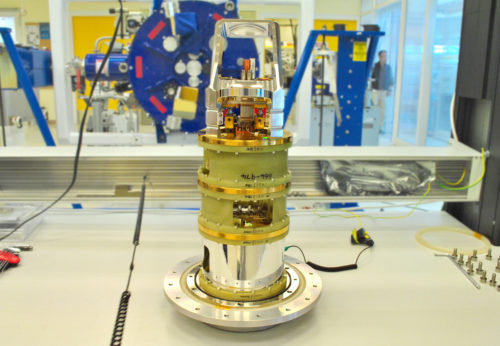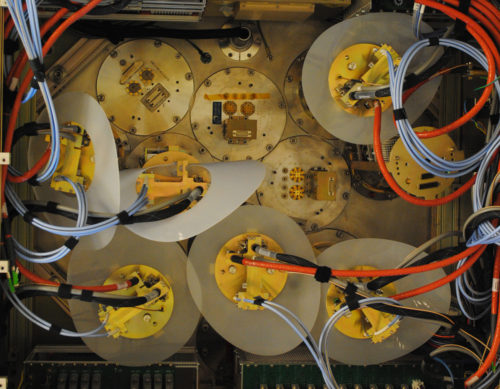ALMA Greatly Improves Capacity to Search for Water in Universe
17 July, 2015 / Read time: 4 minutes
After more than five years of development and construction, ALMA successfully opened its eyes on another frequency range after obtaining the first fringes with a Band 5 receiver, specifically designed to detect water in the local Universe. This band will also open up the possibility of studying complex molecules in star-forming regions and protoplanetary discs, and detecting molecules and atoms in galaxies in the early Universe, looking back about 13 billion years.

This image shows one of the Band 5 receiver cartridges built for the Atacama Large Millimeter/submillimeter Array (ALMA) waiting to be integrated into the Front End at the OSF technical laboratories. Credit: ALMA (ESO/NAOJ/NRAO), N. Tabilo.
ALMA observes the Universe in radio waves: light that is invisible to the human eye. The weak electromagnetic glow from space is captured by the array of 66 antennas, each with diameters up to twelve metres. Their receivers transform this weak radiation into an electrical signal.
To scout a broad range of frequencies, each ALMA antenna is equipped with up to ten different receivers, each one specially designed to cover a specific range of wavelengths. The new Band 5 receiver is the eighth type to be integrated and covers a range of wavelengths from 1.4 to 1.8 millimetres (frequencies from 163 to 211 GHz), probing a part of the electromagnetic spectrum that has only been poorly explored before.

Left. Detail of a Band 5 receiver integrated into a Front End with all the others Bands (3 to 10). Credit: ALMA (ESO/NAOJ/NRAO), N. Tabilo - Right. Band 5 receiver integrated into a Front End with all the others Bands (3 to 10). Credit: ALMA (ESO/NAOJ/NRAO), N. Tabilo
"Band 5 will open up new possibilities to explore the Universe and bring new discoveries," explains ESO's Gianni Marconi, who is responsible for the integration of Band 5. "The frequency range of this receiver includes an emission line of water that ALMA will be able to study in nearby regions of star formation. The study of water is, of course, of intense interest because of its role in the origin of life."
With Band 5 ALMA will also be able to probe the emission from ionised carbon from objects seen soon after the Big Bang, opening up the possibility of probing the earliest epoch of galaxy formation. "This band will also enable astronomers to study young galaxies in the early Universe about 500 million years after the Big Bang," added Gianni Marconi.

ALMA Band 5 first fringe. With a baseline of 1 kilometer, two antennas pointed to the Orion Molecular Cloud detecting an H2O Maser at 183.3 GHz. When the signals from both antennas are correlated in phase, an emission line can be identified. Credit: ALMA (ESO/NAOJ/NRAO), Band 5 Integration Team.
The Band 5 receivers were originally designed and prototyped by Onsala Space Observatory's Group for Advanced Receiver Development (GARD) at Chalmers University of Technology in Sweden, in collaboration with the Rutherford Appleton Laboratory, UK, the European Southern Observatory (ESO) and the University of Chile, under the European Commission (EC) supported Framework Programme FP6 (ALMA Enhancement). ) starting in 2006. Six of these receivers have been built under the FP6 contract and supplied to ALMA. The Band 5 project is developed in collaboration between ESO, and the US National Radio Astronomy Observatory (NRAO). [1]
After having successfully tested the prototypes, the first production-type receivers were built and delivered to ALMA by a consortium of NOVA and GARD in the first half of 2015. Two receivers were used for the first light. The remainder of the 73 receivers ordered, including spares, will be delivered between now and 2017.
Notes
[1] ESO placed the European contract for the cryogenically cooled receivers with NOVA, the research school for astronomy in the Netherlands, in partnership with Onsala Space Observatory's Advanced Receiver Development group. NRAO build the high-precision local oscillators that tune the receivers, so that the output from all antennas can be precisely combined to make high-resolution images.
More information
ALMA is a partnership of ESO (representing its member states), NSF (U.S.) and NINS (Japan), along with NRC (Canada), NSC and ASIAA (Taiwan), and KASI (South Korea), in cooperation with the Republic of Chile. The Joint ALMA Observatory is operated by ESO, AUI/NRAO and NAOJ.
Contact:
Nicolás Lira
Education and Public Outreach Assistant,
Joint ALMA Observatory
Santiago, Chile
Tel: +56 2 2467 6519
Cell: +56 9 9445 7726
Email: [email protected]





